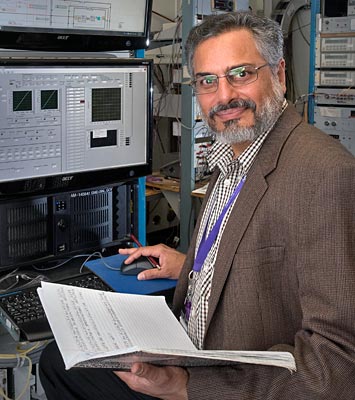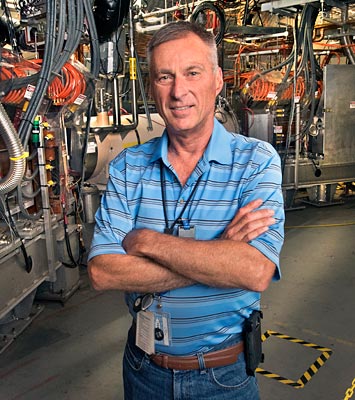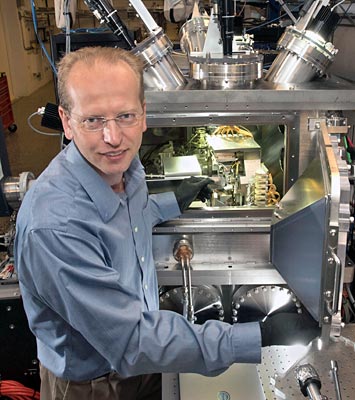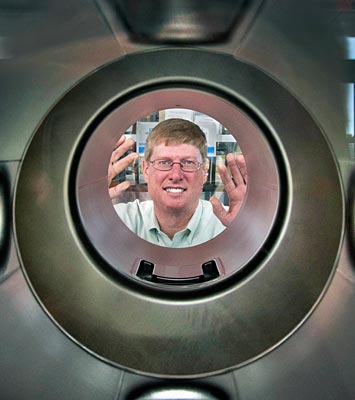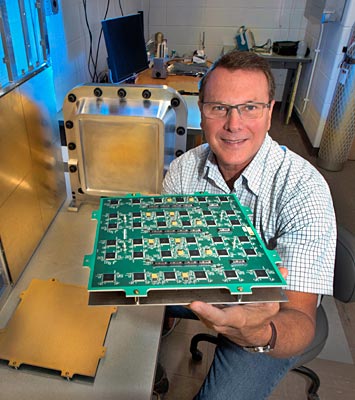2015 Engineering Award Recipients
July 30, 2015
Engineering Awards are presented to recognize distinguished contributions to the Laboratory’s engineering and computing objectives. The 2015 Engineering Award recipients are:
Piyush Joshi • Superconducting Magnet Division
Piyush Joshi is receiving this Engineering Award for his contributions as chief electrical engineer in constructing and testing a superconducting magnetic energy storage (SMES) system, which uses superconducting magnetic coils to store energy with near-zero energy loss and nearly infinite cycle life.
This high profile project was funded by the American Recovery and Reinvestment Act through the U.S. Department of Energy’s Advanced Research Projects Agency-Energy (ARPA-E). It built upon the Superconducting Magnet Division's technological advances for nuclear and high energy physics research, applying them for new uses in storing electricity generated from wind and solar power systems.
For the SMES project, Piyush made significant contributions in developing "quench" detection and protection that protects the magnetic coils and electronics from excessive heat created as the system switches from superconducting to resistive states. Piyush also led discussions to establish standards for signals in an integrated control system that connects individual components and governs their processes. Despite logistical and technical challenges, the goal of operating a complete charge-discharge cycle was accomplished one day before the deadline, thanks in large part to Piyush's commitment, expertise, and efforts.
Michael Mapes • Collider-Accelerator Department
Michael Mapes is being recognized for his extraordinary engineering and leadership skills benefiting the Collider-Accelerator Department. His expertise on ultra-high vacuum technology, design, preparations, and operations has helped the Relativistic Heavy Ion Collider (RHIC) become a leading scientific facility that has surpassed original expectations. Besides leading an engineering and technical support group for many years, Mike has also been a key leader engineering beamlines and accelerator systems for the NASA Space Radiation Laboratory, Electron Beam Ion Source, Energy Recovery Linac, and Brookhaven Linac Isotope Producer. Mike seamlessly assures that equipment for RHIC is built and processed under very stringent ultra-high vacuum requirements. His dedication, performance, and reliability are critical to the successful operations of these facilities.
Mike’s “hands-on” techniques—along with his leadership, engineering skills, and consistent support for safe operations—continues to be essential for planning new projects such as the proposed electron-ion collider "eRHIC."
Evgeny Nazaretski • National Synchrotron Light Source II
For five years, physicist Evgeny Nazaretski has led the effort aimed to develop the x-ray microscope for the Hard X-ray Nanoprobe beamline at the National Synchrotron Light Source II (NSLS-II). This instrument provides unprecedented x-ray imaging capabilities at the nanoscale, setting the stage for groundbreaking scientific discoveries.
Evgeny and his colleagues did not build an x-ray microscope that would simply work under ideal conditions. They carried out extensive R&D work to understand and test various components of the complex system, building multiple prototype instruments prior to completion of the project. Throughout the development process, Evgeny and his colleagues have set world records in terms of stability and resolution. The success of so much cutting-edge nano-imaging science that has occurred—and will occur—at NSLS-II is possible because of Evgeny's work.
James Rose • National Synchrotron Light Source II
In a very real sense, the National Synchrotron Light Source II (NSLS-II) would not be operating as it is today without Jim Rose. Jim's work as leader of the radio frequency group was instrumental in meeting deadlines to successfully commission the newest major research facility at Brookhaven. NSLS-II's radio frequency system is complex and multi-faceted, and Jim's engineering background made him ideally suited for specifying, designing, building, procuring, installing, and testing components—from the 3 gigahertz linear accelerator to the super-conducting 500 megahertz main and 1.5 gigahertz harmonic radio frequency systems.
During the development and construction of NSLS-II, Jim taught and guided his team of talented engineers, even as his own role changed countless times. He acted as RF, electrical, mechanical, and cryo engineer and became involved in procurement, managing subprojects, and more. Jim was always ready to switch hats as the situation required. His consistent ability to find solutions that are simultaneously innovative, timely, and cost-effective have helped affirm the Laboratory's place as a world leader in the rapidly evolving field of accelerator technology.
Neil Schaknowski • Instrumentation Division
Neil Schaknowski has made outstanding engineering contributions to the development of thermal neutron detectors for both fundamental science and national security applications.
Neil’s complex engineering innovations—particularly through close collaborations with Oak Ridge National Laboratory and the Australian Nuclear Science and Technology Organisation—have positioned Brookhaven as a world leader in helium-3-based detectors. Neil also designed and fabricated a more practical, field-deployable neutron detector, a key advance for the Lab’s Nonproliferation and National Security Department.
Neil’s work has also advanced the scientific mission of the Relativistic Heavy Ion Collider (RHIC). He developed instrumentation for the first practical measurements of thermal neutron flux at both the STAR and PHENIX detectors. Those hardware advances provide fundamental physics knowledge that is essential for planning eRHIC, the Lab’s potential electron ion collider.
Neil’s collective experience with multi-layer circuit boards, application-specific integrated circuits, pressure vessel regulations, and high-purity gas mixtures has led to extremely reliable, cost effective, and dynamic detector technology. His ongoing innovations continue to inspire new and exciting collaborations and have even led to major strategic partnerships and Work for Others contracts.
2015-5859 | INT/EXT | Newsroom




